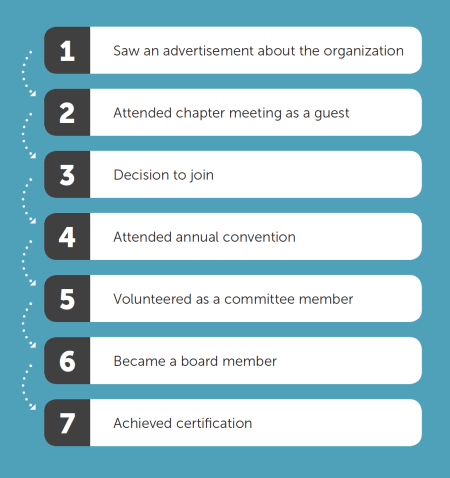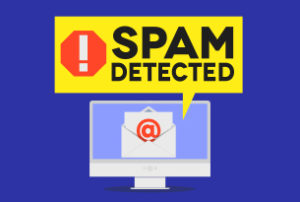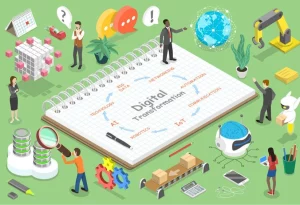Has your organization ever mapped out your members’ journey? Journey mapping is the documentation of all touchpoints that a specific stakeholder group encounters during a particular process.
If you haven’t gone through this process professionally, you certainly have in your personal life. Every day we are taken through customer journeys for he products and services we use without even realizing it. Every step of our journey has been carefully orchestrated by marketers, subtly leading you to the ultimate purchase goal.
But journey mapping isn’t just for the private sector. As a non-profit organization or association, you can map out your members’ journey to better understand their perspective, with the goal of getting more members, retaining existing ones, and boosting trust and authority in your organization.
Journey mapping can be done at a high level, or a micro-level – both are useful. But where do you start? In this blog, we review how to map the member journey, and key questions to ask at each stage. This is the fourth blog in our Digital Transformation Series. If you missed the first three articles no problem – catch up here! And if you just can’t wait to get the full scoop, download our Digital Transformation for Associations e-book NOW!
Figuring out each step (or touchpoint) of your members’ journey isn’t complicated. Keep in mind that your members will go on various types of journeys with your organization. And just like travelling, each journey is different.
Let’s start with the high-level example below, in which an association member goes from awareness to full organizational engagement.

The steps are quite straightforward. But this isn’t the end of the process, it’s just the beginning. Ask these 6 questions for each touchpoint:
1: What is the emotional state of the member?
This may be the most important question you can ask. What the member does at each step is strongly influenced by how they feel at that moment. In this example, this person goes through several cycles of curiosity, being intrigued and interested, which leads to increasing levels of engagement with the organization.
2: What questions might they have?
If you can’t anticipate and address their questions at each touchpoint, they may feel less engaged or lose interest. In this example there are key questions including:
- Step 1: What is this organization all about? How could they help my professional development?
- Step 2: How did I feel at that meeting? Was it useful to me? Is it worth attending again?
- Step 3: Should I join this organization? How much does it cost? What are the membership benefits?
- Step 4: Did I enjoy the convention? Was it a useful networking event? Did I learn key information?
- Step 5: Did I enjoy my volunteer experience? Is it worth the time and effort to volunteer again?
- Step 6: How do I feel about being a Board member? How could it help me? How could my role help others in my profession?
3: What barriers might prevent them from moving to the next touchpoint?
Reducing barriers will naturally encourage the person to move to the next step. In this example, we see a few potential barriers including:
Cost: How much does it cost to join? Attend the convention? Achieve certification?
Time: How long is the convention? What is the time commitment to volunteer on a committee? Be a Board member? Achieve certification?
4: What motivations do they have to move to the next touchpoint?
Answering questions and reducing barriers is one side of the equation. But this must be balanced by learning more about their motivations. In this example, as the person deepened their level of engagement with the organization, they liked what they saw. Perhaps they felt that this organization could successfully support their professional development and grow their networks. This journey could have ended right where it began at Step 1. But it didn’t. This person felt increasing motivation to get more involved with the organization at each touchpoint, leading to their final achievement of certification.
5: What stimulus could encourage them to move to the next touchpoint?
Once you know their motivations you can design stimuli to match. In this example, Step 2 is crucial. After they attended a chapter meeting as a guest, they had to answer a big question: to join or not to join? Actions taken to encourage them to join the organization could include:
- Email from the Chapter Lead asking them about their meeting experience, and offering to have a phone or videoconference call to answer any questions.
- Survey from the organization asking them to rate their meeting experience, and comment on how they could improve.
- Email campaign from the organization highlighting membership benefits (as relevant to their motivations).
6: Have there been past complaints or service gaps at this touchpoint?
This is a question that many organizations simply don’t ask. There is little point in mapping out the member journey if you can’t learn from the past, and improve on the quality of your customer service. In this example, Step 4 is another crucial decision-making point. Going from attending a convention to volunteering as a committee member (Step 5) is a big jump. We see many organizations put significant time, money, and effort into their annual conventions. Yet, many neglect to properly follow-up with attendees to increase engagement. This key gap is easily remedied by leveraging the right Association Management System (AMS) or Customer Relationship Management System (CMS) that can segment your members by geography, interest, events attended, and more.
In this blog, we have shared 6 key questions to ask about each touchpoint in the member journey, to help you understand your organization’s engagement efforts from the member seat. Don’t miss our next blog, where we cover how and why each touchpoint is an opportunity for digital transformation.
If you want to see the whole picture NOW, download our e-book, Digital Transformation for Associations! Divided into 10 sections for easy reading, consider it your ‘start here’ digital transformation guide.











